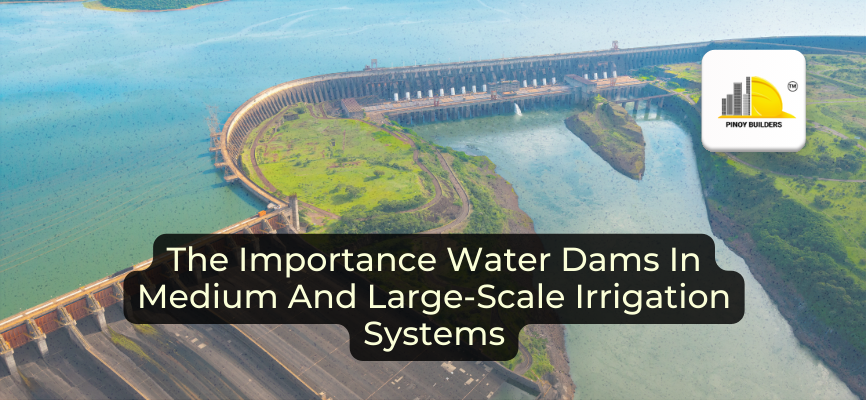Mainly used as a source or reservoir of water, dams have many forms. Each type of dam delivers a different function, although many modern dams are now multi-purpose. Nowadays, dams can provide water for farming and crop production while serving other purposes like water reservoirs, being a source of hydro electrical power, and even an infrastructure that has a hand in soil preservation.
For millennia, humans have been reaping the benefit of water dams for agriculture, societal, recreational, or even economic functions. This comes as no surprise since dams are designed to hold or redirect one of the most vital compounds known to mankind: water. In this article, we will discuss the importance of water dams in irrigation, as well as their role in farming, crop production, drinking water availability, and hydropower.
The Importance Of Water Dams In Large and Medium-Scale Irrigation Systems
In the Philippines, three types of irrigation systems are described by the National Irrigation Administration (NIA). Referred to as National Irrigation Systems, the three types of irrigation systems found in the country are labeled national, communal, and private. All irrigation systems are managed by the NIA and service fees are changed to those who benefit from the systems.
Among the three types of irrigation systems, two of them are commonly connected to water dams, namely run-of-the river diversion utilizing forebay dams, and storage or reservoir from usually a main water dam. The third irrigation system is pump irrigation, which is not always directly linked to a dam, but instead uses water that is either sourced from groundwater in wells, collected rainwater, or water from municipal water banks.
Communal & Private/Medium-Scale Irrigation System

Image from Green Africa Magazine
The importance of water dams in large and medium-sized irrigation systems can not be understated, as it provides indispensable benefits to society. A medium-sized irrigation system is a system that accumulates less than 1,000 hectares of land. Usually used in farmlands, medium-sized irrigation systems are referred to as communal irrigation systems, in which NIA renders the crucial participation of the farmers and workers to build the system and contribute to its maintenance afterward.
While in no shape or form are they small, communal irrigation systems are usually smaller operations meant to directly provide water to lands that are mainly used for cereal crops and vegetable production. Important crops such as rice, barley, corn, and other grains use communal irrigation systems, which in turn are processed and distributed to markets to feed and sustain a growing population.
National/Large-scale Irrigation System

Image from USA ERS
Although water dams in the Philippines tend to vary in form and overall measurements inclusive of extensions and forebay dams, they do tend to have similarities in functions, especially modern dams that are built to accommodate various sectors of the country. For example, national dams in the Philippines can be used by the agricultural industry for farming and irrigation, the electrical power industry for energy supply, and even the tourism industry for recreational purposes.
Among the most important functions of national dams is their role in large-scale irrigation systems. Similar to the irrigation systems used in communal and private operations, large-scale irrigation systems also provide water to agricultural lands that cater to more than 1,000 hectares of space. The biggest difference between the two is that NIA is the developer as well as the main administrative body of national irrigation systems, while it is assisted by the Irrigators Associations in terms of maintenance.
Important Benefits of Water Dams Such As A Headwater For Essential Resources
Apart from its vital role in agriculture, water dams also function as a water reservoir that can be used as a source for drinking water and even hydro-generated electricity. While not all water dams have the same function, some water dams in the Philippines, like the Agus II, IV, V, VI, and VII operate as hydroelectric power plants that were envisioned by the country’s National Power Corporation. In addition to this, water dams can also be a great source of drinking water, although it will have to go through a different process of filtration that should be emphasized is not the same as the process used in irrigation systems for watering the crop fields.
Water Dams and Irrigation Systems
The significance of water dams in irrigation systems is very apparent, as it is not only an essential aspect of agriculture itself, but it is needed by our nation’s farmers and other important sectors of society. Water dams are massive infrastructures and the construction of each requires careful research and planning. White its role in agriculture, access to drinking water, and hydroelectric power is significant, the solution for improvement does not necessarily lie in the construction of more dams, but rather the development of more and increasingly efficient irrigation systems.
Resource:
- National Irrigation System (n.d.) CONSTRUCTION OF IRRIGATION SYSTEMS. Retrieved from: https://www.nia.gov.ph/content/construction-irrigation-systems
- Jackson, D., Brown, J. (9 May 2023) dam, engineering. Britannica. Retrieved from: https://www.britannica.com/technology/dam-engineering
- Tortajada, C. (n.d.) Dams: An Essential Component of Development. ASCE Library. Retrieved from: https://ascelibrary.org/doi/10.1061/%28ASCE%29HE.1943-5584.0000919










